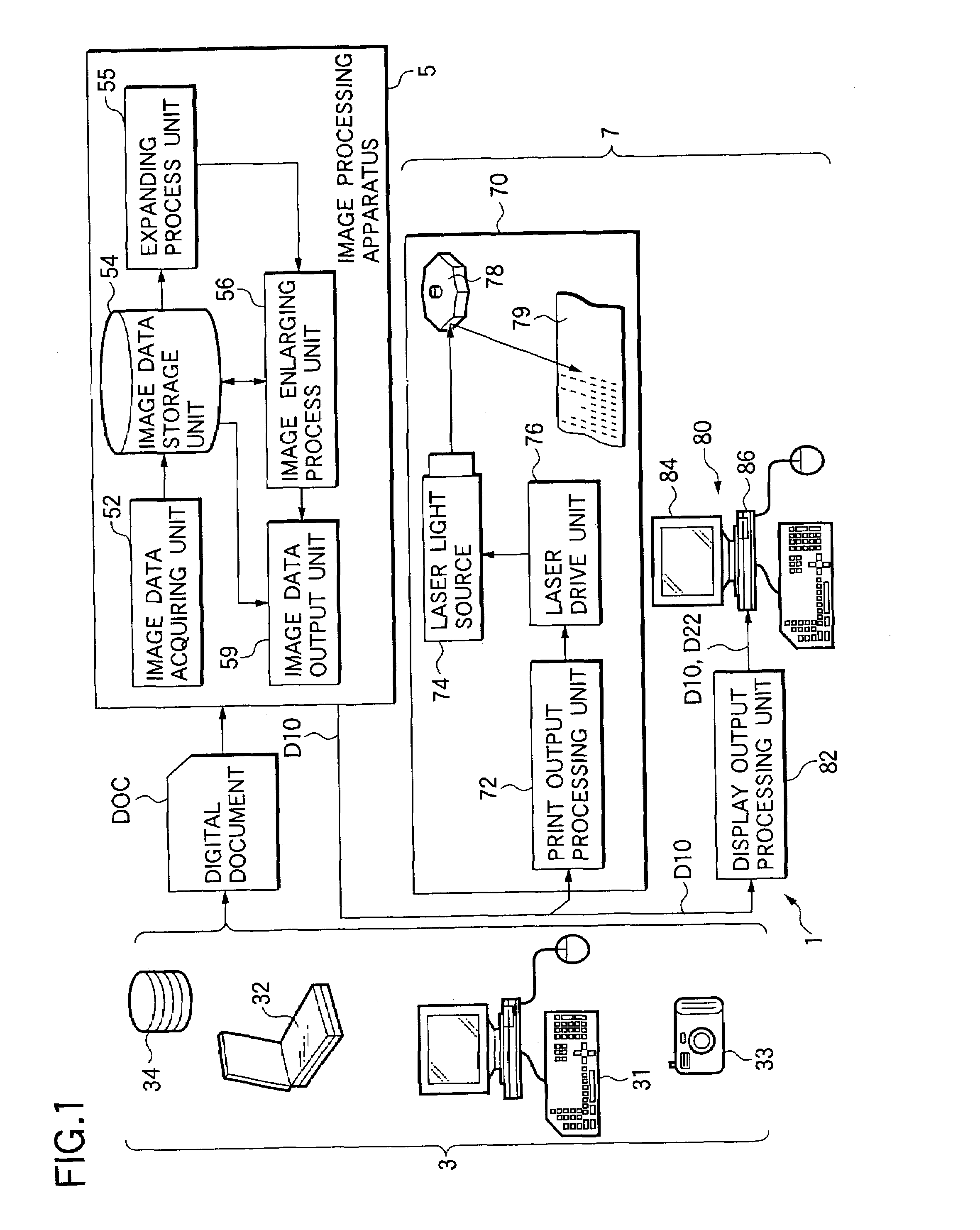Image processing apparatus and program
a technology of image processing and program, applied in the field of image processing, can solve the problems of large degree of visible image quality deterioration, blurring phenomenon essentially occurring, and the entire image may become blurred, and achieve the effect of enlarged image and effectively using the featur
- Summary
- Abstract
- Description
- Claims
- Application Information
AI Technical Summary
Benefits of technology
Problems solved by technology
Method used
Image
Examples
first embodiment
[0064]FIG. 6 is an explanatory diagram for explaining a process sequence executed in the image processing apparatus 5 according to the above-described first embodiment, more specifically, such a process sequence that an image enlarging process operation executed in the image enlarging process operation 56 is interested. FIG. 6(A) indicates a diagram for showing one example of a domain block image, a range block image, a reduced range block image, and an enlarged range block image, whereas FIG. 6(B) is a flow chart for describing a first example of the process sequence.
[0065]First of all, as an initial condition for starting the enlarging process operation, it is so assumed that subject image data which has been acquired by the image data acquiring unit 52 and will be enlarge-processed has been previously stored in the image data storing unit 54. Under such an initial condition, the image enlarging process unit 56 firstly secures a memory region in the image data storing unit 54 for ...
fifth embodiment
[0092]FIG. 9 is a diagram for illustrating one example of combinations of enlarging ratios divided by the enlarging ratio dividing unit 561. In this example shown in FIG. 9, as to such a designated enlarging ratio (for instance, designated enlarging ratio is 6, 8, 9 etc.) which may be expressed by a product of two values among the designated enlarging ratios, it is divided into two enlarging ratios. In the enlarging ratio dividing unit 561, this combination of the enlarging ratios is previously prepared as table data so that the enlarging ratio dividing unit 561 may utilize this table data. Alternatively, the enlarging ratio dividing unit 561 may calculate this combination of these enlarging ratios every time it is required. Alternatively, although the designated enlarging ratio is divided into the two enlarging ratios in this illustrated example, this designated enlarging ratio may be divided into three, or more enlarging ratios. For instance, when the designated enlarging ratio is...
second embodiment
[0093]FIG. 10 is a flow chart for describing process sequential operations executed in the image processing apparatus 5 of the The image enlarging process unit 56 firstly divides a designated enlarging ratio “r” so as to produce a combination of the divided enlarging ratios (step S102), and then sets a first enlarging ratio and executes a similar process operation to that of the above-described first example (step S104). For example, among the designated enlarging ratios, such an enlarging ratio which can be expressed by a product of two values (e.g., designated enlarging ratio is 6, 8, 9 and so on) is divided into two enlarging ratios.
[0094]Next, the process operation of the image processing apparatus 5 is explained with reference to such an example that after a two-times enlarged image (image enlarged by two times) has been formed by way of the above-described first embodiment, this enlarged image is again enlarged in the two-times enlarging ratio so as to obtain a four-times enl...
PUM
 Login to View More
Login to View More Abstract
Description
Claims
Application Information
 Login to View More
Login to View More - R&D
- Intellectual Property
- Life Sciences
- Materials
- Tech Scout
- Unparalleled Data Quality
- Higher Quality Content
- 60% Fewer Hallucinations
Browse by: Latest US Patents, China's latest patents, Technical Efficacy Thesaurus, Application Domain, Technology Topic, Popular Technical Reports.
© 2025 PatSnap. All rights reserved.Legal|Privacy policy|Modern Slavery Act Transparency Statement|Sitemap|About US| Contact US: help@patsnap.com



